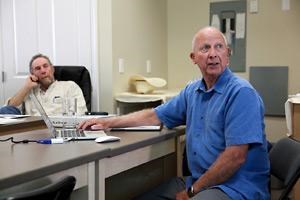Formation of a broadly based regional recreation commission is an initiative that will be considered by Powell River Regional District board of directors.
The final report from the regional recreation initiative, conducted by Gary Young, from Young and Associates, was presented at the Thursday, July 17, committee of the whole meeting. Young delivered a similar report to the City of Powell River in June.
Jim Palm, city director, questioned Young regarding his recommendation to establish a new joint recreation commission, a prominent feature of Young’s report. The eight-person commission would be made up as follows: two regional district elected representatives; two city council members; one school trustee; one organized sport representative; one arts community representative; one community halls representative.
“One thing that came to mind in your presentation was the lack of representation from Sliammon [Tla’amin Nation],” Palm said. “Would you add a seat if you could get buy-in from Sliammon?”
Young said he certainly would.
Young’s report states that recreation needs to be managed in a partnership to meet the collective needs of the regional district’s citizens. The city’s parks, recreation and cultural services are seen as a cornerstone of new economic development plans, he said.
In his summary of recommendations, Young suggested that the bookings of active fields continue to be assigned to the recreation staff.
Another recommendation was to assign community recreation staff services to support and extend the services provided through the community halls.
Young suggested the regional district enter into a 70-30 per cent funding model to Electoral Areas A, B, C and D to fund a full set of recreation services, including the community halls and Powell River Recreation Complex. This is similar to the library funding model.
Finally, Young recommended that the Tla’amin be invited to participate in any partnership discussions.
In order to identify use of recreation facilities in Powell River, as identified in the recreation review, Points of View Consulting conducted a community survey, with the city, regional district Areas A, B, C and D, and Tla’amin participating. Randomly selected residents from those areas were invited to participate and 397 responses were received. Some of the data in the survey was also used in the city’s recreation complex service review.
Use of recreation facilities by regional district residents was fairly similar to those attributed to city residents. In terms of the top five facilities within the region, 53 per cent of city residents made use of the public library in the past year, while 47 per cent of regional residents did so. The Evergreen Theatre was next, with a 50 per cent—47 per cent breakdown. The aquatic centre followed, with 46 per cent of city residents surveyed using it in the last year, and 54 per cent of regional residents. The swimming pool was the most highly used facility for regional residents. More regional residents had been to Dwight Hall and the ice arena this past year. In the survey, 40 per cent of regional residents had been to both facilities, while for city residents, 38 per cent had been to Dwight Hall and 32 per cent had been to the arena.
Statistically, families with children living at home were more likely to use the recreation complex. A total of 90 per cent had been to the recreation complex, compared to 70 per cent of households with no children.
Use of the fitness centre at the recreation complex peaked for the 45 to 54 age group.
Young told the regional board that in terms of improvements needed for recreation programs, the main concern was lack of variety, particularly for general interest or non-sport activities. A need for more programming for specific age groups and scheduling not being convenient for employed people or those who live outside the city was specified.
A recurring observation is there needs to be more opportunities for youth at the city’s and regional district’s recreation facilities.
Colin Palmer, regional board chair, said he appreciates this report.
“We have a mine of information,” he said. “We’ve never had anything like this. It’s really significant. What we do with it is another matter. There are lots of challenges that we are going to have.”



